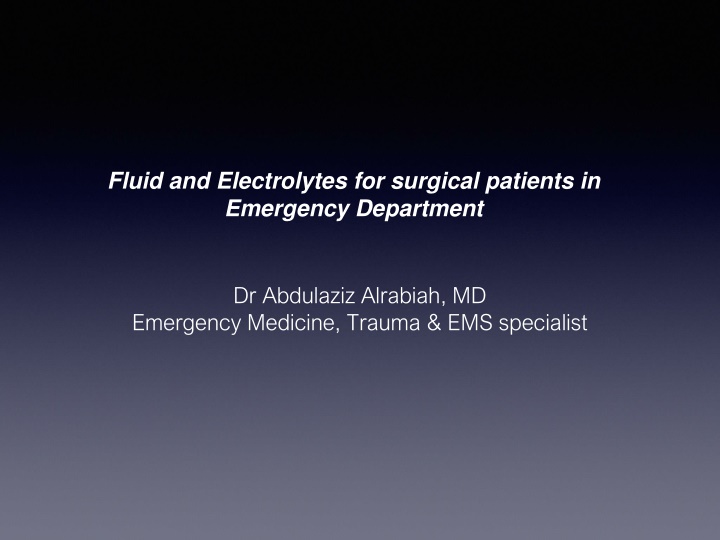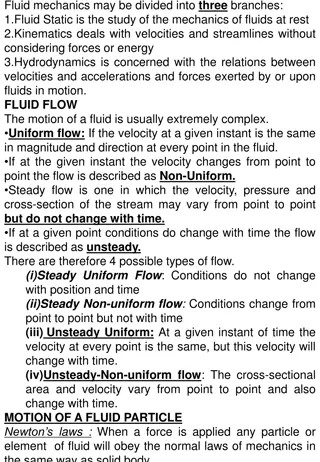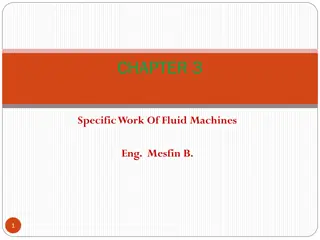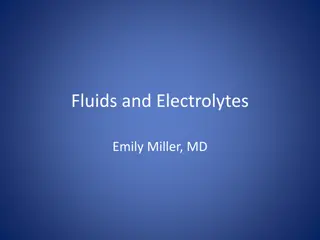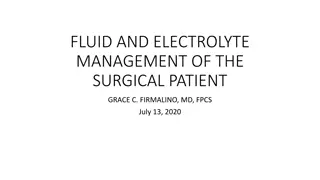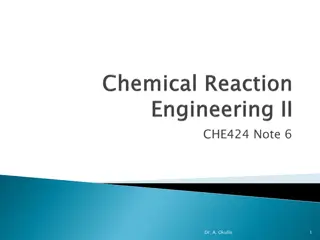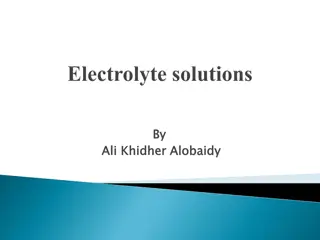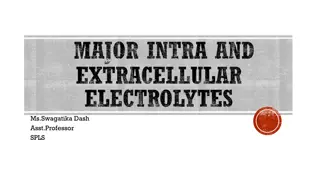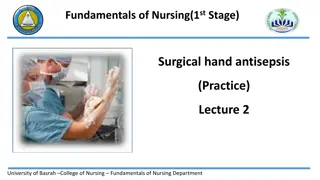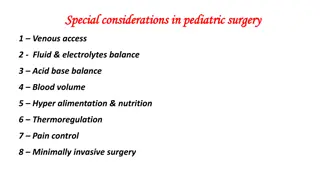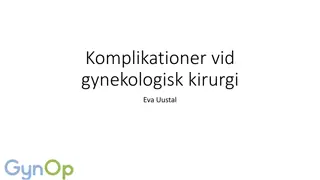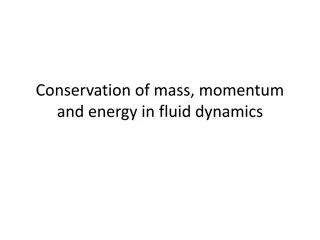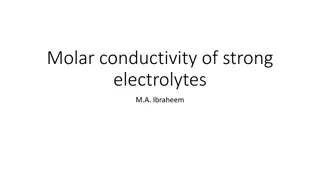Fluid & Electrolytes for Surgical Patients in Emergency Setting
Importance of IV fluid types, electrolyte imbalances, and classifications for surgical patients in the emergency department. Explore isotonic, hypotonic, and hypertonic solutions, crystalloids like normal saline and Ringer lactate, and the indications for their use.
Download Presentation

Please find below an Image/Link to download the presentation.
The content on the website is provided AS IS for your information and personal use only. It may not be sold, licensed, or shared on other websites without obtaining consent from the author.If you encounter any issues during the download, it is possible that the publisher has removed the file from their server.
You are allowed to download the files provided on this website for personal or commercial use, subject to the condition that they are used lawfully. All files are the property of their respective owners.
The content on the website is provided AS IS for your information and personal use only. It may not be sold, licensed, or shared on other websites without obtaining consent from the author.
E N D
Presentation Transcript
Fluid and Electrolytes for surgical patients in Emergency Department Dr Abdulaziz Alrabiah, MD Emergency Medicine, Trauma & EMS specialist
Objectives IV Fluids different types and classifications indications +/- contraindication Electrolytes Hyper / Hypo Na Hyper / Hypo K Hyper / Hypo Ca
Types of IV fluid 3 types ( tonicity / osmolarity ) Isotonic Hypotonic Hypertonic
Isotonic Hypotonic Hypertonic Osmolarity < 250 mOsm/L shift of fluid from Intravascular to intracellular space hydrate the cell > to cell Osmolarity >375 mOsm/L shift fluid from IC to IV dehydrate the cell > cell shrinkage Osmolality : 250-375 mOsm/L no fluid shifting only increase IV
Classifications of IV fluid Crystalloids Colloids
Crystalloids 0.9 % Normal saline Ringer lactate 0.45% Normal saline (1/2 NS) 5% Dextrose 5% dextrose + 0.45% NS 2.5% dextrose + 0.45% NS 4% dextrose + 018% NS 10% dextrose 3% normal saline
0.9% Normal saline component Na 150 mmol/L CL 150 mmol/L isotonic solution : 308 mOsm/L PH 5.3 indications replacement of fluid loss i.e. DKA, upper GI bleeding therapy for hyponatremia shock contraindication hypernatremia hyperchloremia > metabolic acidosis
lactated ringer (Ringer lactate) components Na 130 mmol/L Cl 109 mmol/L Lactate 28 mmol/L K 4 mmol/L Ca 1.5 mmol/L isotonic solution : 275 mOsm/L indications preferred fluid for trauma patient less hyperchloremic metabolic acidosis than 0.9 % NS
5% dextrose component Glucose 50g / L isotonic solution : 260 mOsm/L indication Hypoglycaemia hypernatremia additional maintenance fluid most effective fluid in establish urine flow in euvolaemic patient (i.e. patient going for pelvic ultrasound and needs full bladder)
0.45% (1/2) normal saline component Na 75 mmol/L Cl 75 mmol/L hypotonic solution : 154 mOsm/L indication DKA ( 2nd hour to avoid hyperchloemic metabolic acidosis) therapy of hypernatermia
to make think more complicated!!! 3% NS = 0.9 % NS X 3 used in acute symptomatic hyponatremia 10% dextrose Glucose 100 g/ L 5% dextrose + 0.45% NS i.e. in DKA 2.5% dextrose + 0.45% NS 4% dextrose + 018% NS
Colloids more expensive than crystalloid solution not shown to have any benefit over crystalloid solution in initial resuscitation Adverse effects best avoided in the bleeding trauma patient due to potential anti-coagulant effects: impair fibrin polymerisation decrease clot elasticity decrease clot weight reduce von Willebrand factor levels antiplatelet effects
4% albumin (Albumex4) drives from human plasma PH 7 albumin 40g/L Na 140 mmol/L Cl 128 mmol/L K 0.12 mmo/L octanoate 6.4 mmol/L isotonic solution : 250 mosm/L
4% albumin (Albumex4) indications hypovolaemia associated with altered capillary permeability / hypoalbuminaemia burns after 12 hours shock and albumin < 20 g/L possible role in enhancing binding of highly protein bound toxic agents (aspirin, TCADs) complications fluid over load ( t 1/2 5 days in blood ) infection expensive no mortality advantage over normal saline in volume expansion of critically ill patient
other colloid fluid 20% albumin ( Albumen 20 ) : 200 g / L Gelofusine Starch solution
Na Major extracellur electrolytes normal Na level in blood 135 mEq/L - 145mEq/L
Hyponatremia1 Na+ < 135mmol/L Mild 125-134 : Asymptomatic Moderate 120-124 : lethargy , confusion , anorexia, nausea, vomiting Severe <120 : muscle cramp, weakness, convulsions, coma
Hyponatremia2 causes and types
Hyponatremia3 HISTORY speed of onset more important than level most patients won t be symptomatic until Na+ < 125mmol/L fluid intake/output nausea vomiting neuropsychiatric symptoms muscular weakness headache lethargy psychosis raised ICP seizures coma medications! ROS to find precipitant and organ dysfunction co-morbidities: adrenal disease, liver disease
Hyponatremia4 EXAMINATION volume status neurological complications (increased ICP, lateralizing signs) INVESTIGATIONS diagnostic U+E (Na+, glucose, renal function) plasma osmolality plasma proteins and lipids urinary Na+
Hyponatremia5 Management calculate Na deficit Na deficit= (desired Na-current Na) x (0.6 x body weight) correction In acute severe hyponatraemia, aim for 1-2mEq/hour correction In chronic severe hyponatraemia aim for 0.5-1mEq/hour correction. Hypertonic saline replacement 3% saline (513mEq/L) by giving (deficit/513) to the patient at the rate of 1mEq/hour over 4 hours
Hypernatremia Na > 145mmol/L causes water loss:each1 L loss > 3-5mEq rise in Na sweat, burn, vomiting, diarrhoea, fistula, Diabetes insipidus. decrease water intake i.e. hypothalamic lesion > disorder thirst perception increase salt intake primary hyperaldosteronism ectopic ACTH
Hypernatremia 2 clinically dehydration increase risk of IC bleed , due to brain shrinkage
Hypernatremia 3 correction Stop ongoing losses Correct water deficit Correct sodium deficit if hypovolaemic Treat the underlying cause Complications of treatment Intracerebral haemorrhage Coma and seizures Cerebral oedema (if correction too rapid)
Hypernatremia4 calculate water deficit total body water X (serum Na -140) / (140) 0.5 X Kg X (serum Na -140) / (140) Choice of fluid : oral free water or 5% dextrose over 24-48 hr with reduction rate of 0.5 - 1 mmol/L
Hyperkalemia normal K 3.5 - 5.1 Hyperkalemia >5.1 causes increase intake ( oral or IV ) endogenous K load haemolysis rhabdomyolysis burns TLS increase activity trauma
Hyperkalemia decrease K excretion renal failure drugs i.e. k sparing diuretics Pseudohyperkalemia ( Factitious ) hemolysis ( Venipuncture ) Thrombocytosis Leukocytosis
Hyperkalemia Clinical features are often non specific Generalised muscle weakness Flaccid paralysis and parathesia of the hands and feet Lethargy, Confusion, Weakness and Palpitations
Hyperkalemia ECG changes
Hyperkalemia Management Ca Cl 10% Ca Gluconate 10% Insulin and Glucose 10 Unit act rapid + 50 g Glucose ( 25 ml ) sodium bicarb : 100 ml , 8.4% Salbutamol 10 mg Neb Calcium resonium 15 gm orally or rectally Dialysis ? Frusemide 20 - 80 mg Normal saline
Hypokalemia K < 3.5 causes decrease intake increase loss GIT loss : vomit, NGT , Diarrhoea , fistula renal loss diuretics, mannitol primary and secondary hyperaldosternism cushing syndrome renal artery stenosis
Hypokalemia transcellular shift alkalosis dextrose, insulin infusion Pernicious anaemia, AML
Hypokalemia Clinical Weakness Fatigue Paralysis and rhabdomyolysis Respiratory difficulty Constipation/ileus Leg cramps
Hypokalemia Correction Minimise further K loss (commonest is GI loss and drugs) Give potassium replacement Correct magnesium and phosphate deficiencies Oral K Chlorvescent (K 14mmol, Cl 8mmol) Span K (KCL 8 mmol) nteric coated, delayed release Intravenous Maximum 20mEq/hr unless imminent cardiac arrest CVL required if > 10mmol/hr Requires ECG monitoring
Hypercalcemia normal 2.2 - 2.6 mmol/L causes bone malignancy hyperparathyroidism addison s , pheochromocytoma dehydration TB , sarcoidosis drugs i.e. Lithium , thiazides, Vit D Factitious hyper-albumin prolong cuff time
Hypercalcaemia Clinical symptoms Stones (Renal colic and hypercalcaemic stones) Bones (Increased osteolysis and fractures) Psychic moans (Depression, confusion, hallucinations and coma) Abdominal groans (Anorexia, N, V, constipation, PUD, pancreatitis) Other Muscle weakness, malaise, hyporeflexia Confusion, apathy, decreased memory Nephrogenic diabetes insipidus (Polyuria and polydipsia)
Hypercalcaemia Complication Cardiac Arrhythmia and ECG changes QT shortening (Prolonged with low K, Ca, Mg) Prolonged PR Widened QRS Notched QRS with increased voltage AV block ..CHB ..cardiac arrest
Hypercalcemia Management Fluid , fluid , fluid Haemodialysis i.e. CVS or renal compromise Calcitonin , Bisphosphonates i.e. reduce bone resorption & reduce GIT absorption
Hypocalcemia Ca < 2.2 mmol/L causes Hypoparathyroidism Vitamin D deficiency Acute pancreatitis Hyperphosphataemia Hypomagnesaemia Diuretics (frusemide) Pseudohypoparathyroidism Congenital disorders (e.g. DiGeorge syndrome) Critical illness (e.g. sepsis) Factitious (e.g. EDTA blood tube contamination)
Hypocalcaemia Symptoms Neuromuscular excitability Carpopedal spasm Tetany Chvostek s sign Trousseau s sign Seizures
Hypocalcemia ECGs Changes Hypocalcaemia causes QTc prolongation primarily by prolonging the ST segment. Dysrhythmias are uncommon, although atrial fibrillation has been reported. Torsades de pointes may occur, but is much less common than with hypokalaemia or hypomagnesaemia.
Hypocalcaemia Management treat the cause replace ca Oral IV Ca 10 ml Ca Gluconate , or Ca chloride indication for IV Ca symptomatic Ca < 0.8 hyper kalmia CCB overdose after massive transfusion
Thank You aalrabiah@ksu.edu.sa
